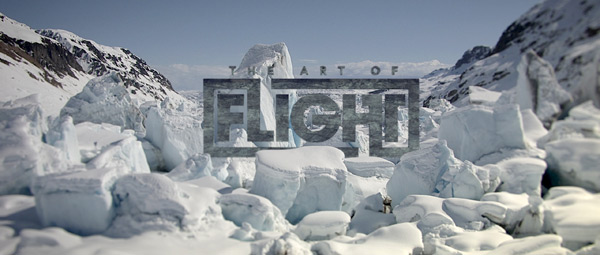The Helio Collective on Creating Pulse-Pounding Opening Titles for the Sports-Action Film
Two years in the making, The Art of Flight is a sports-action film that takes audiences on an epic snowboarding journey. To capture the film’s adrenalin-producing action, director Curt Morgan (That’s It, That’s All), traveled with snowboarding superstar Travis Rice and his band of brothers as they navigated some of the wildest terrain on the planet, including stops in Jackson Hole, WY, Aspen, CO, Alaska, British Columbia, and Patagonia.
“Working on Art of Flight was an amazing opportunity to combine motion graphics with beautiful live action,” says Chris Murphy, Helio’s founder and creative director. “We were part of everything, including conception, shooting, and editing for the intro title sequence and it really helped us capture the mood and tone of the film.”

Art of Flight begins with a sequence in which Travis Rice boards a plane. As he boards, his metallic-looking logo floats under the plane’s walkway. The model, which resembles metal water droplets, is an extrude NURBS from a vector graphic. Textures were created to simulate the reflection of the surrounding structure. SynthEyes provided a precise track through the entire shot, and RealFlow was used for the effect of the water dripping.
Next, the location shifts to outer space where the flight of an asteroid shooting in from the far reaches of the solar system acts as a visual metaphor for the high-flying action about to come. Headed toward Earth, the asteroid flies past Mars and a series of sponsorship logos, before honing in on the logo for Brain Farm Digital Cinema, the HD production house of the film’s director, Curt Morgan. “V-Ray was really useful here to get the lighting just right for this,” says Jim Menkol, a 3D animator at Helio.
Getting the details right
For the asteroid, Helio’s team used both modeling and texturing techniques to create the complex surfaces, and they used sub-surface scattering to get nice edge detail. “The sub-surface scattering took a lot of tweaking to get what we wanted, since an asteroid wouldn’t really have that much translucency,” adds Menkol. “But we were more concerned with creating a big, menacing rock that looked great in motion.”
C4D’s Dynamics came in handy when animating the asteroid crashing into a few of the small rocks floating in space and splitting them apart. Nitro4D’s fracture plug-in, Thrausi, made it easy for the team to get cut cubes to create the chunks of rock. MoGraph was then used to turn the individual pieces into an entire debris field.
The planet was created on a separate pass and textured using an 8K surface map of Mars, as well as displacement and judicious use of sub-surface scattering. A point light placed fairly far away gave them the look and control they wanted. One last pass using Advanced Render provided some needed atmosphere. “Cinema 4D’s great integration with After Effects gave us complete control during compositing,” Murphy recalls. “Red Bull’s logo ended up being a little too dark and the color was a little off, but the multi-passes allowed us to take care of that in a pinch.”

For the shot of Brain Farm’s Digital Cinema logo, Helio wanted the asteroid to hit the logo and chip off one of its corners. This clever bit of foreshadowing is a nod to the way, later in the film, snowboarders soar so high off of jumps they actually break branches from the tops of trees. “Once again, Thrausi did the cutting and we just threw the asteroid at the logo and let Cinema’s dynamics do the rest,” Menkol explains.

In the windswept Principal Cinematography title shot, shadows of the text on the live-action plate were achieved by camera-matching an infinite ground plane to the valley floor, and using that as a shadow catcher. “Normally when we see 3D titles, they’re either 2D text placed in 3D space, or extremely extruded, which is very difficult to read,” explains Menkol. “We wanted the titles to be integrated with the shot, but we didn’t want that to interfere with the text.”

Available on DVD and iTunes, The Art of Flight is presently on tour worldwide for a special series of theatrical showings. A 3D theatrical release is expected soon. It was the highlight of Helio Collective’s year, Murphy says. “We are a small creative production company that had the opportunity to work on the most influential snowboard film made to date, and these are the types of jobs that make us love our profession.”
For more information: www.heliocollective.com.
Scott Strohmaier is a writer living in Los Angeles living with his wife and son.
Did you enjoy this article? Sign up to receive the StudioDaily Fix eletter containing the latest stories, including news, videos, interviews, reviews and more.












